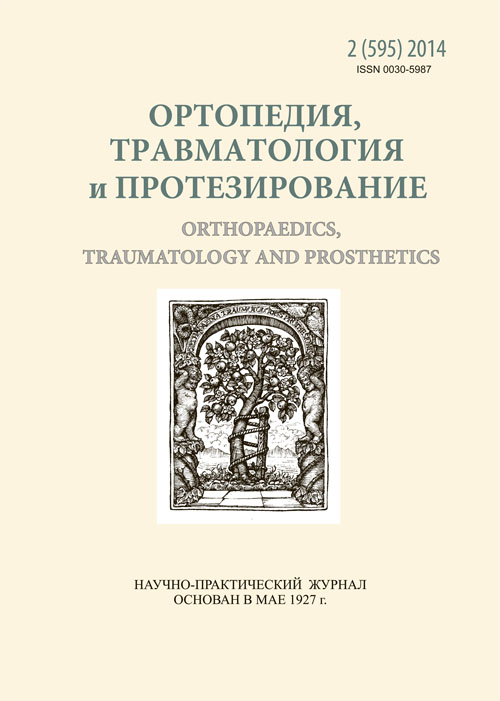Evolution of scoliotic spinal deformity after anterior spinal fusion
DOI:
https://doi.org/10.15674/0030-59872014229-32Keywords:
anterior spinal fusion, idiopathic scoliosis, pseudarthosis, discectomyAbstract
In spite of progress in the modern spinal surgery, development of pseudarthrosis after anterior spinal fusion is still unresolved problem. The purpose of this study is to asses spinal fusion process in idiopathic scoliosis patients after anterior spinal instrumentation. Methods: retrospective analyses of radiographs and computer tomograms have been peen performed in 15 idiopathic scoliosis patients after anterior corrective spinal fusion. It is founded that spinal fusion developed 3 month after the surgery and radiographic Cobb angle values were without changes during 2 years follow-up. Conclusion: key factors for pseudarthrosis prophylaxis after anterior spinal fusion are stable spinal fixation with implant and total discectomy resulting in favorable condition for interbody spinal fusion.References
- McMaster M. J. Stability of the scoliotic spine after fusion / M. J. McMaster // J. Bone Joint Surg. — 1980. — Vol. 62-B. — P. 59–64.
- Recent trends in surgical management of adolescent idiopathic scoliosis: a review of 17412 cases from the Scoliosis Research Society database 2001–2008 / S. K. Cho, L. G. Lenke, K. H. Bridwell, A. Allen: 49th Scoliosis Research Society Meeting. — Lyon, 2013.
- Complications in spinal fusion for adolescent idiopathic scoliosis in the new millennium. A report of the scoliosis research society morbidity and mortality committee / J. D. Coe, V. Arlet, W. Donaldson [et al.] // Spine. — 2006. — Vol. 31. — P. 345–349.
- Pseudarthrosis in primary fusions for adult idiopathic scoliosis: incidence, risk factors and outcome analyses / Y. J. Kim, L. G. Bridwell, L. G. Lenke [et al.] // Spine. — 2005. — Vol. 30. — P. 468–474.
- Prospective radiographic and clinical outcomes of dual-rod instrumented anterior spinal fusion in adolescent idiopathic scoliosis: comparison with single-rod constructs / L. G. Lenke, S. S. Lee, I. Cheng [et al.] // Spine. — 2006. — Vol. 15. — P. 2322–2328.
- Oeullet J. A. Effect of grafting technique on maintenance of coronal and sagittal correction in anterior treatment of scoliosis / J. A. Oeullet, C. E. Johnson // Spine. — 2002. — Vol. 27 (19). — P. 2129–2135.
- Prospective radiographic and clinical outcomes and complications of single rod instrumented anterior spinal fusion in adolescent idiopathic scoliosis / F. Sweet, L. Lenke, K. Bridwell [et al.] // Spine. — 2001. — Vol. 26. — P. 1956–1965.
- Betz R. R. Comparison of anterior and posterior instrumentation for correction of adolescent thoracic idiopathic scoliosis / R. R. Betz, J. Harms, D. H. Clements 3rd, L. G. Lenke // Spine. — 1999. — Vol. 24 (3). — P. 225–239.
- Short segment bone-on-bone instrumentation for single curve idiopathic scoliosis / W. Brodner, W. Yue, H. Moller [et al.] // Spine. — 2007. — Vol. 28. — Р. 224–233.
- The morphological features of tissue in the area of interbody fusion in experimental modeling rats / D. E. Petrenko, N. A. Ashukina, G.V. Ivanov, A. A. Mezentsev // Orthopedics, Traumatology and Prosthetics. — 2012. — № 4. — P. 45-49.
Downloads
How to Cite
Issue
Section
License
Copyright (c) 2014 Dmytro Petrenko, Andrey Mezentsev

This work is licensed under a Creative Commons Attribution 4.0 International License.
The authors retain the right of authorship of their manuscript and pass the journal the right of the first publication of this article, which automatically become available from the date of publication under the terms of Creative Commons Attribution License, which allows others to freely distribute the published manuscript with mandatory linking to authors of the original research and the first publication of this one in this journal.
Authors have the right to enter into a separate supplemental agreement on the additional non-exclusive distribution of manuscript in the form in which it was published by the journal (i.e. to put work in electronic storage of an institution or publish as a part of the book) while maintaining the reference to the first publication of the manuscript in this journal.
The editorial policy of the journal allows authors and encourages manuscript accommodation online (i.e. in storage of an institution or on the personal websites) as before submission of the manuscript to the editorial office, and during its editorial processing because it contributes to productive scientific discussion and positively affects the efficiency and dynamics of the published manuscript citation (see The Effect of Open Access).














